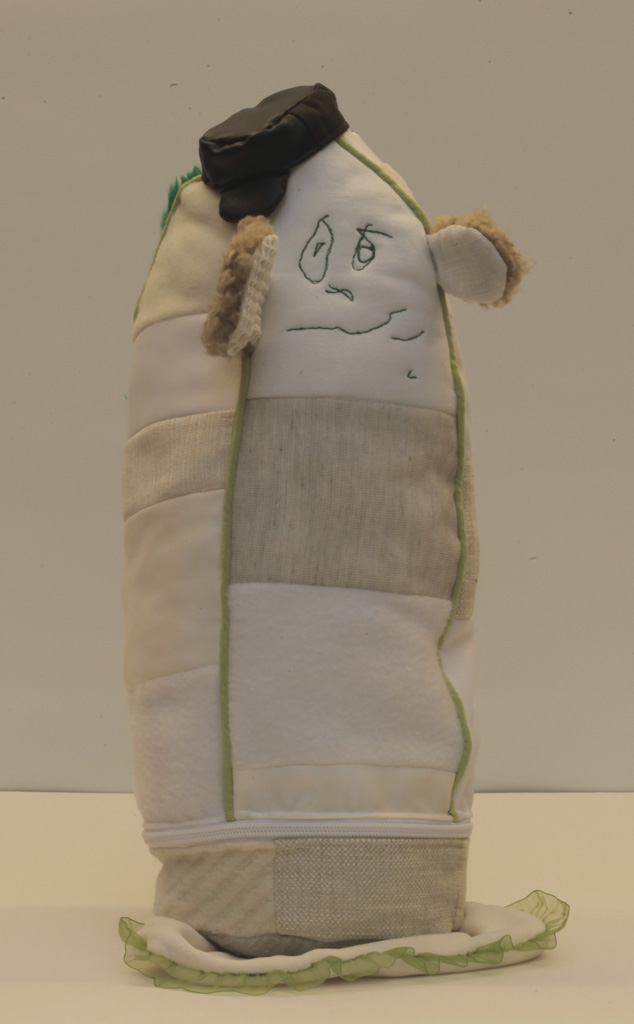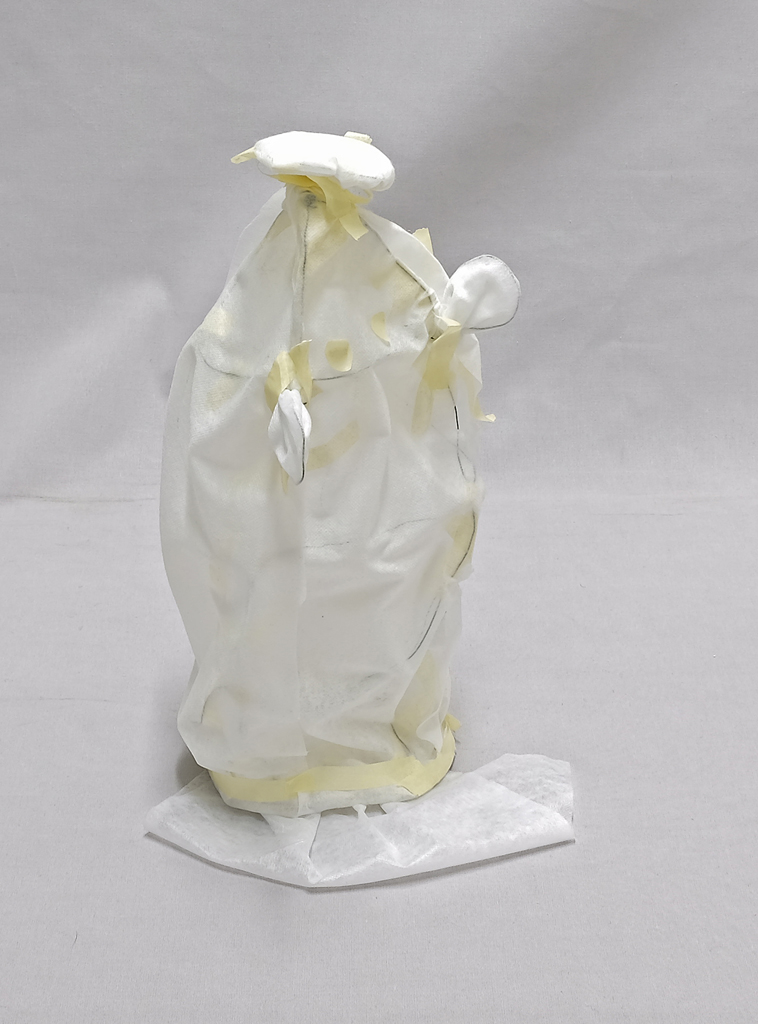A soft toy called Unto Uolevi was acquired for the collections of Helsinki University Museum Flame from the discipline of craft teacher training at the Faculty of Educational Sciences. This soft toy has its origins in a drawing by a daycare-aged child. The toy was created in 2012 on a course on the basics of craft science given by Professor Pirita Seitamaa-Hakkarainen and University Lecturer Henna Lahti. Some of the students participated in a project where the process of craft design was investigated through the creation of stuffed toys. The different stages of Unto Uolevi were recorded in the museum collections: the drawing, a prototype, a trial run and the final version.

Toy design as an assignment
The compulsory course on the basics of craft science for first-year teacher students in the discipline included lectures on design theories and issues, as well as a hands-on assignment. The goal was to learn to collaborate by carrying out a design project together. In 2012, the assignment was to design a three-dimensional toy based on a child’s drawing. Later on, during a sewing technique course, the students made the toys from textile materials. Most of the toys were later donated to the children who produced the drawings.

The students formed three teams, each of which designed a toy with a different appearance: a zebra, a car and Unto Uolevi. Each team included three or four students. The assignment consisted of several elements: obtaining a child’s drawing from children in daycare, drawing up a mind map and a material collage, creating a model and patterns, producing a prototype and, finally, sewing a toy. Each team was assigned different tools for design: pen and paper (the zebra team), tape and cardboard (the car team), and wire and gauze (the Unto Uolevi team). The teams’ work was recorded on video, and the activities displayed in the recordings analysed afterwards. It turned out that the design process was best supported by wire and gauze, which were used precisely in the design of Unto Uolevi. A scholarly article on the project was published in the Techne Series: Research in Sloyd Education and Craft Science journal in 2016 (see the source list).

Creativity and crafts
In the study of creative design, it has been observed that social cognition, or the joint understanding of knowledge and its processing by several people, is a key factor. Knowledge-based achievements often derive from the organised and goal-oriented collaboration of many people. Such collaboration is evidenced in everyday life, for example, by the fact that even though people do handicrafts based on traditional materials and techniques, they often like to adapt the models used according to their personal preferences. In other words, the work of previous designers lays the groundwork for new creative effort. Handicrafts are considered rewarding and interesting because they enable people to realise their new and experimental ideas and be creative.
More professionally oriented design also always builds on the work and ideas of previous designers, which inspire the development of something new. While creativity hinges on new insights, designers must at the same time be aware of the ideas of others. Creative products are compared to existing ones, and creative ideas are rarely the result of the work of a single person. Instead, they stem from both social interaction and creative individuals. This is evident also in Unto Uolevi: the finished product is based on children’s imagination and the professional skills of the makers.

History of craft science
The scholarly discipline of craft science brings art, science and technology together. All of the various manifestations of crafts are potential research topics, from children’s crafting to sculptors’ work, from artisans to the design process and finished products.
In Finland, the discipline of craft science is founded on the teaching of women’s crafts, launched at the Helsinki Craft School in 1881. The training of craft teachers commenced there a few years later. While a number of committees considered reforming the training over the years, it was not until 1975 that a decisive change took place. At the time, craft teacher training was incorporated into the University of Helsinki, resulting in the establishment of a new discipline.

The first professorship in craft teacher training was established in 1981. Its teaching field was in textile studies, more precisely the design and manufacturing processes of crafted textile products. In other words, the study of design was included in the discipline of craft science from the very beginning. Pirkko Anttila was the first permanent professor in the discipline. Later on, the teaching field of the position was changed from textile studies to craft science, a more scholarly concept. Research in the field gradually picked up steam, and the first doctoral thesis in the field of craft science was completed in 1994. In the thesis, Minna Uotila examined clothing as a network of meanings, drawing parallels between clothing and selfhood: the human self may not be attributable to the mind alone, but also extends, through clothing, to the world outside the self.
Craft science continues to investigate the engagement of school- and daycare-aged children in design processes. Based on the outcomes of the project that resulted in the creation of Unto Uolevi, research on the topic has continued and even expanded in a project entitled Maker-Centered Learning: Cultivating Creativity in Tomorrow’s Schools.

Jaana Tegelberg, Head of Collections
Translation: University of Helsinki Language Services
Sources
Kojonkoski-Rännäli Seija. Maailmaan laajeneva minuus ja pukeutumisen kuva. Punomo Käsityöblogit. https://blogit.punomo.fi/seijanblogi/2017/07/21/maailmaan-laajeneva-minuus-ja-pukeutumisen-kuva/ [accessed 8 January 2024]
Koskennurmi-Sivonen Ritva, Seitamaa-Hakkarainen Pirita. Luovuus. https://mlab.taik.fi/polut/Luovuus/teoria_luovuus.html [accessed 11 December 2023]
Lahti Henna, Kangas Kaiju, Koponen Veera, Seitamaa-Hakkarainen Pirita. Material mediation and embodied actions in collaborative design process. Techne Series: Research in Sloyd Education and Craft Science A, 23(1), 15–29. 2016. https://helda.helsinki.fi/server/api/core/bitstreams/e3f59faf-5deb-4f1a-9fd6-3ee8c9a8aa9b/content [accessed 13 December 2023]
Maker-Centered Learning: cultivating creativity in tomorrow’s schools. Research project from 1 December 2021 to 31 August 2025 at the Department of Education. Participants: Kangas, Kaiju; Seitamaa-Hakkarainen, Pirita; Bosch, Noora; Aljabaly, Mariam. https://researchportal.helsinki.fi/fi/projects/maker-centered-learning-cultivating-creativity-in-tomorrows-schoo [accessed 18 January 2024]
Salo-Mattila Kirsti. Käsityönopettajan koulutuksen historioita 1800-luvulta 2000-luvulle. Kasvatustieteellisiä tutkimuksia, numero 32. Helsinki 2018.
Salo-Mattila Kirsti. Naiskäsityön opetuksesta käsityötieteeseen. In: Heinämies Kati (ed.). Helsinki University Museum. Tiedettä, taidetta, historiaa. Helsinki 2003.
